
The Hubble sequence is a morphological classification scheme for galaxies published by Edwin Hubble in 1926. It is often colloquially known as the Hubble tuning-fork diagram because the shape in which it is traditionally represented resembles a tuning fork. It was invented by John Henry Reynolds and Sir James Jeans.

An irregular galaxy is a galaxy that does not have a distinct regular shape, unlike a spiral or an elliptical galaxy. Irregular galaxies do not fall into any of the regular classes of the Hubble sequence, and they are often chaotic in appearance, with neither a nuclear bulge nor any trace of spiral arm structure.

A lenticular galaxy is a type of galaxy intermediate between an elliptical and a spiral galaxy in galaxy morphological classification schemes. It contains a large-scale disc but does not have large-scale spiral arms. Lenticular galaxies are disc galaxies that have used up or lost most of their interstellar matter and therefore have very little ongoing star formation. They may, however, retain significant dust in their disks. As a result, they consist mainly of aging stars. Despite the morphological differences, lenticular and elliptical galaxies share common properties like spectral features and scaling relations. Both can be considered early-type galaxies that are passively evolving, at least in the local part of the Universe. Connecting the E galaxies with the S0 galaxies are the ES galaxies with intermediate-scale discs.

Galaxy morphological classification is a system used by astronomers to divide galaxies into groups based on their visual appearance. There are several schemes in use by which galaxies can be classified according to their morphologies, the most famous being the Hubble sequence, devised by Edwin Hubble and later expanded by Gérard de Vaucouleurs and Allan Sandage. However, galaxy classification and morphology are now largely done using computational methods and physical morphology.

A barred spiral galaxy is a spiral galaxy with a central bar-shaped structure composed of stars. Bars are found in about two thirds of all spiral galaxies in the local universe, and generally affect both the motions of stars and interstellar gas within spiral galaxies and can affect spiral arms as well. The Milky Way Galaxy, where the Solar System is located, is classified as a barred spiral galaxy.

A dwarf galaxy is a small galaxy composed of about 1000 up to several billion stars, as compared to the Milky Way's 200–400 billion stars. The Large Magellanic Cloud, which closely orbits the Milky Way and contains over 30 billion stars, is sometimes classified as a dwarf galaxy; others consider it a full-fledged galaxy. Dwarf galaxies' formation and activity are thought to be heavily influenced by interactions with larger galaxies. Astronomers identify numerous types of dwarf galaxies, based on their shape and composition.
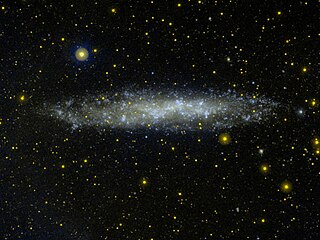
NGC 3109 is a small barred Magellanic type spiral or irregular galaxy around 4.35 Mly away in the direction of the constellation of Hydra. NGC 3109 is believed to be tidally interacting with the dwarf elliptical galaxy Antlia Dwarf. It was discovered by John Herschel on March 24, 1835 while he was in what is now South Africa.

NGC 1569 is a dwarf irregular galaxy in Camelopardalis. The galaxy is relatively nearby and consequently, the Hubble Space Telescope can easily resolve the stars within the galaxy. The distance to the galaxy was previously believed to be only 2.4 Mpc. However, in 2008 scientists studying images from Hubble calculated the galaxy's distance at nearly 11 million light-years away, about 4 million light-years farther than previously thought, meaning it is a member of the IC 342 group of galaxies.
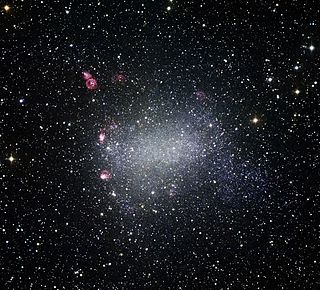
NGC 6822 is a barred irregular galaxy approximately 1.6 million light-years away in the constellation Sagittarius. Part of the Local Group of galaxies, it was discovered by E. E. Barnard in 1884, with a six-inch refractor telescope. It is the closest non-satellite galaxy to the Milky Way, but lies just outside its virial radius. It is similar in structure and composition to the Small Magellanic Cloud. It is about 7,000 light-years in diameter.

A dwarf spiral galaxy is the dwarf version of a spiral galaxy. Dwarf galaxies are characterized as having low luminosities, small diameters, low surface brightnesses, and low hydrogen masses. The galaxies may be considered a subclass of low-surface-brightness galaxies.
A barred irregular galaxy is an irregular version of a barred spiral galaxy. Examples include the Large Magellanic Cloud and NGC 6822. Some barred irregular galaxies may be dwarf spiral galaxies, which have been distorted into an irregular shape by tidal interactions with a more massive neighbor.
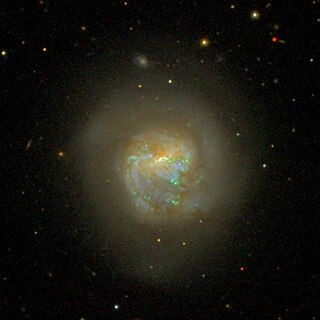
NGC 5713 is a peculiar, asymmetric galaxy in the constellation Virgo. Although classified as a spiral galaxy by most galaxy catalogs, NGC 5713 is very different from most normal spiral galaxies. While most spiral galaxies either have either two well-defined spiral arms or a filamentary spiral-like structure, this spiral galaxy has only one visible spiral arm in its disk. This makes it a galaxy of the Magellanic type. Gravitational interactions with the nearby spiral galaxy NGC 5719 may be responsible for producing the disturbed, asymmetric structure including the single spiral arm.

NGC 4618 is a distorted barred dwarf galaxy in the constellation Canes Venatici. The galaxy is formally classified as a Sm galaxy, which means that its structure vaguely resembles the structure of spiral galaxies. The galaxy is sometimes referred to as a Magellanic spiral because of its resemblance to the Magellanic clouds.

NGC 4625 is a distorted dwarf galaxy in the constellation Canes Venatici. The galaxy is formally classified as a Sm galaxy, which means that its structure vaguely resembles the structure of spiral galaxies. The galaxy is sometimes referred to as a Magellanic spiral because of its resemblance to the Large Magellanic Cloud's single-arm structure.
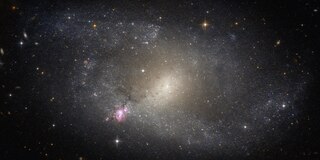
NGC 5398 is a barred spiral galaxy in the southern constellation of Centaurus. It was discovered June 3, 1836 by John Herschel. Distance estimates range from 5.39 Mpc to 18.30 Mpc. The tip of the red-giant branch method yields a distance of 11.6 Mpc, while the Tully–Fisher relation shows values of around 8.5 Mpc. It is receding with a heliocentric radial velocity of 1,219 km/s.
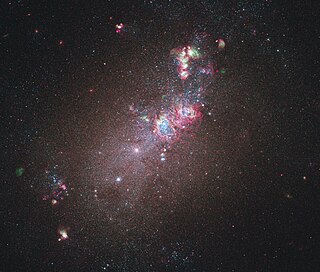
NGC 4214 is a dwarf barred irregular galaxy located around 10 million light-years away in the constellation Canes Venatici. NGC 4214 is a member of the M94 Group.

NGC 3432 is an edge-on spiral galaxy that can be found in the northern constellation of Leo Minor. It was discovered by German-British astronomer William Herschel on March 19, 1787. This galaxy is located at a distance of 40 million light-years (12.3 Mpc) from the Milky Way. It is interacting with UGC 5983, a nearby dwarf galaxy, and features tidal filaments and intense star formation. Because of these features, it was listed in Halton Arp's Atlas of Peculiar Galaxies.

NGC 925 is a barred spiral galaxy located about 30 million light-years away in the constellation Triangulum. The morphological classification of this galaxy is SB(s)d, indicating that it has a bar structure and loosely wound spiral arms with no ring. The spiral arm to the south is stronger than the northern arm, with the latter appearing flocculent and less coherent. The bar is offset from the center of the galaxy and is the site of star formation all along its length. Both of these morphological traits—a dominant spiral arm and the offset bar—are typically characteristics of a Magellanic spiral galaxy. The galaxy is inclined at an angle of 55° to the line of sight along a position angle of 102°.

NCG 5204 is a Magellanic spiral galaxy located about 14.5 million light-years away from Earth in the constellation of Ursa Major and is a member of the M101 Group of galaxies. It has a galaxy morphological classification of SA(s)m and is highly irregular, with only the barest indication of any spiral arm structure. The galaxy's most prominent feature is an extremely powerful X-ray source designated NGC 5204 X-1. This has resulted in the galaxy being the target of several studies due to the strength of the source and its relative proximity to Earth.

NGC 3664 is a magellanic barred spiral galaxy in the constellation of Leo. It is located about 80 million light years away from Earth, which means, given its apparent dimensions, that NGC 3664 is approximately 50,000 light years across. It was discovered by Wilhelm Tempel on March 14, 1879. It is a member of the NGC 3640 Group of galaxies, which is a member of the Leo II Groups, a series of galaxies and galaxy clusters strung out from the right edge of the Virgo Supercluster.























